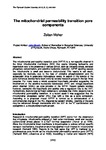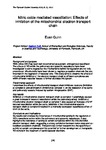The mitochondrial permeability transition pore components
| dc.contributor.author | Molnar, Z. | |
| dc.date.accessioned | 2019-05-13T14:54:56Z | |
| dc.date.available | 2019-05-13T14:54:56Z | |
| dc.date.issued | 2010 | |
| dc.identifier.citation |
Molnar, Z. (2010) 'The mitochondrial permeability transition pore components', The Plymouth Student Scientist, p. 245-254. | en_US |
| dc.identifier.issn | 1754-2383 | |
| dc.identifier.uri | http://hdl.handle.net/10026.1/13906 | |
| dc.description.abstract |
The mitochondrial permeability transition pore (MPTP) is a non-specific channel in the inner mitochondrial membrane (IMM) that opens following ischaemia and reperfusion due to the presence of various stimuli, such as oxidative stress, elevated phosphate concentration, and adenine nucleotide depletion. MPTP opening causes the mitochondria to swell and become dysfunctional. This results in cell death, especially by necrosis, due to the loss of oxidative phosphorylation and the subsequent drop in adenosine triphosphate levels. In search of the identity of the pore numerous studies have been done by several research groups in the last three decades. For many years a widely accepted hypothesis prevailed suggesting the involvement of the adenine nucleotide translocase (ANT) and voltage-dependent anion channel (VDAC) as core proteins of the MPTP. Recent genetic studies, however, contradict this hypothesis and ascribe only a regulatory role to the ANT. Furthermore, there is now sufficient evidence to conclude that VDAC plays no role in mitochondrial permeability transition. In a recent study it was suggested that the mitochondrial phosphate carrier (PiC) may fulfil a role as a pore component. According to a proposed model MPTP is formed as a consequence of a conformational change in the PiC, triggered by calcium binding. Opening of the pore may be enhanced through interactions with the ANT in the “c” conformation and cyclophilin-D, a mitochondrial matrix protein. | en_US |
| dc.language.iso | en | en_US |
| dc.publisher | University of Plymouth | |
| dc.rights | Attribution 3.0 United States | * |
| dc.rights.uri | http://creativecommons.org/licenses/by/3.0/us/ | * |
| dc.subject | mitochondrial | en_US |
| dc.subject | permeability | en_US |
| dc.subject | MPTP | en_US |
| dc.subject | mitochondrial permeability transition pore | en_US |
| dc.subject | inner mitochondrial membrane | en_US |
| dc.subject | adenine nucleotide translocase | en_US |
| dc.subject | mitochondrial phosphate carrier | en_US |
| dc.subject | voltage-dependent anion channel | en_US |
| dc.title | The mitochondrial permeability transition pore components | en_US |
| dc.type | Article | |
| plymouth.issue | 1 | |
| plymouth.volume | 3 | |
| plymouth.journal | The Plymouth Student Scientist |





